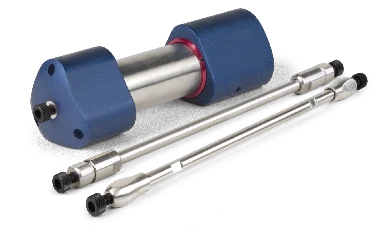
High Performance Liquid Chromatography (HPLC)
What Is HPLC?
High-Performance Liquid Chromatography (HPLC) is an analytical technique used to separate, identify, and quantify components in complex mixtures. Operating typically at pressures below 6,000 psi, HPLC systems pump a liquid mobile phase through a column packed with fine stationary-phase particles, usually 3–10 µm in diameter. These particles create extensive surface area for interaction between analytes and the stationary phase, enabling efficient and reproducible separations. By precisely controlling mobile-phase composition, flow rate, and temperature—and coupling the system with sensitive detectors—HPLC provides high-resolution and quantitative results across diverse applications, including drug identity confirmation, purity testing, and therapeutic monitoring.

How Do HPLC Columns Work?
HPLC columns are engineered to separate complex mixtures into individual components with high precision. Inside each column, the stationary phase interacts with analytes as they are carried through by the mobile phase under high pressure. The effectiveness of this separation depends on selecting the right combination of column chemistry, particle size, and mobile phase conditions. By fine-tuning these variables, scientists can achieve optimal resolution, sensitivity, and reproducibility for a wide range of analytical applications.
HPLC Column Types
Shop by HPLC Column Brands
Particle Types
Benefits of HPLC
- Robustness & Reliability – HPLC systems are extremely durable, less sensitive to minor pressure fluctuations, and can handle “dirtier” samples (like food, environmental, or plant extracts) without clogging as easily.
- Method Transferability – Most regulatory and compendial methods (USP, EP, JP) are written for HPLC, making it the default platform in QC and regulated environments.
- Cost Efficiency – HPLC instruments, columns, and maintenance are generally less expensive. UHPLC columns and hardware can be more costly and cn wear faster under high pressure.
- Sample Load Capacity – Because HPLC columns typically use larger particle sizes (3–5 µm), they often tolerate higher injection volumes, which can be useful for preparative work or when analytes are at low concentrations.
- Ease of Use – HPLC has broader accessibility; analysts may prefer it for routine, high-throughput work where speed isn’t the primary concern.




















